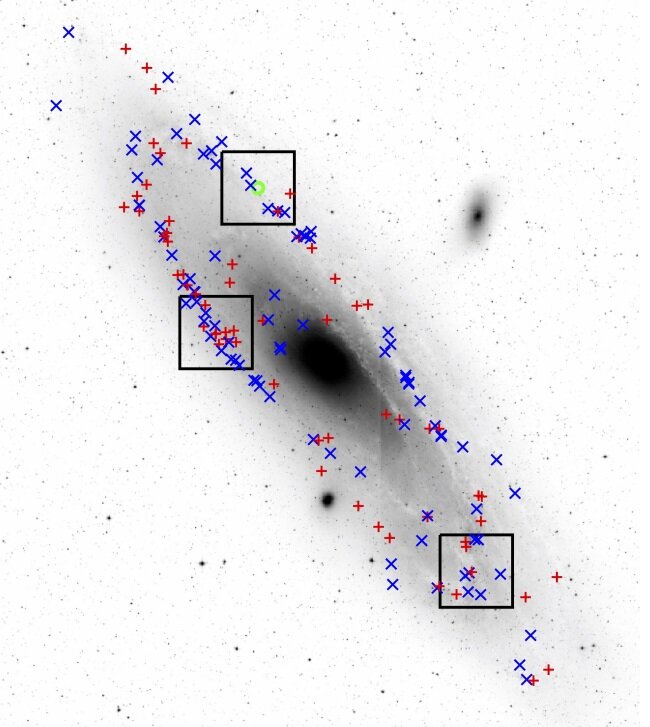

Using the 4.3-m Lowell Discovery Telescope (LDT), astronomers Kathryn F. Neugent and Philip Massey, have observed the nearby Andromeda galaxy. In result, they detected 19 new Wolf-Rayet stars in this galaxy. The finding was reported in a paper published June 22 on the pre-print server arXiv.
Wolf-Rayet (WR) stars are extremely hot and very luminous stars with strong, broad helium emission lines. Observations show that WRs are massive stars at an advanced stage of stellar evolution and losing mass at a very high rate. To date, only a few hundreds such stars have been discovered, mostly in the Milky Way.
Now, Kathryn F. Neugent from the Harvard-Smithsonian Center for Astrophysics (CfA) and Philip Massey from the Lowell Observatory, report the detection of another batch of WR stars. They detected 19 new objects of this type in the neighboring Andromeda galaxy (also known as Messier 31, or M31) using LDST’s Large Monolithic Imager (LMI).
“Our improved imaging data and spectroscopic follow-up confirmed 19 new WRs across three small fields in M31,” the researchers wrote in the paper.
The scientists investigated 30 WR candidates with LMI in late 2021 and spectroscopically confirmed 19 of them using the 6.5-m MMT telescope in the second half of 2022, Most of them turned out to be of the WN type (nitrogen-rich). The newfound WRs are generally fainter than the previously known sample of such stars in the Andromeda galaxy, due to slightly increased reddening.
It was noted that the vast majority of the newly detected WR stars were not found in the earlier galaxy-wide survey due to the lack of observational sensitivity. The astronomers added that the median magnitude (in the WN filter of the LMI) is 21.0, compared to the median WN magnitude of the 150 previously known WRs, which is 19.2.
The authors of the paper estimate that about 60 more Wolf-Rayet stars are left to be found in the Andromeda galaxy. Given that WRs aren’t evenly distributed across this galaxy, but they are generally confined to their birthplaces, the researchers plan to focus on these specific regions in order to identify more stars of this type.
Summing up the results, the astronomers noted that the overall ratio of WN-type to WC-type (carbon-rich) WRs for Andromeda remains unchanged with their newest findings. They plan to continue the current survey, with the aim of completing the census of WR stars population in this galaxy.
“We look forward to continuing this survey in the upcoming observing seasons…. Our updated sample will better constrain the RSG/WR [red supergiant/Wolf-Rayet] ratio discussed in Massey et al. (2021a), allow for more accurate comparisons with evolutionary models, and ultimately help us better understand the evolution and end states of massive stars,” the researchers concluded.
More information:
Kathryn F. Neugent et al, Newly Discovered Wolf-Rayet Stars in M31, arXiv (2023). DOI: 10.48550/arxiv.2306.11949
Journal information:
arXiv
© 2023 Science X Network
Citation:
Nineteen new Wolf-Rayet stars discovered in the Andromeda galaxy (2023, June 29)
retrieved 29 June 2023
from https://phys.org/news/2023-06-nineteen-wolf-rayet-stars-andromeda-galaxy.html
This document is subject to copyright. Apart from any fair dealing for the purpose of private study or research, no
part may be reproduced without the written permission. The content is provided for information purposes only.

